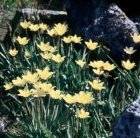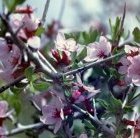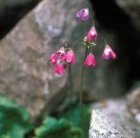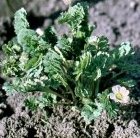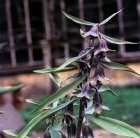 |
QUICK SEARCH
MO PROJECTS:
Africa
Asia/Pacific
Mesoamerica
North America
South America
General Taxonomy
Photo Essays
Training in Latin
America
MO RESEARCH:
Wm. L. Brown Center
Bryology
GIS
Graduate Studies
Research Experiences
for Undergraduates
Imaging Lab
Library
MBG Press
Publications
Climate Change
Catalog Fossil Plants
MO DATABASES:
W³MOST
Image Index
Rare Books
Angiosperm
Phylogeny
Res Botanica
All Databases
INFORMATION:
What's New?
People at MO
Visitor's Guide
Herbarium
Jobs & Fellowships
Symposium
Research Links
Site Map
Search
ORNAMENTAL PLANTS IN THEIR NATURAL HABITATSC. Kazakstan
Malus sieversii, a regional apple tree 2-10 m (6-30 ft) tall, flowers in spring and yields abundant fruit in autumn. The city of Almaty, which means "Father of Apples," derives its name from this apple species, which grows mainly at the base of northern slopes. Hawthorn Crataegus chlorocarpa and barberies Berberis sphaerocarpa, both bearing edible fruits, are among the showy and useful shrubs. Berberis iliensis, a rare shrub to 3 m (10 ft) tall, is particularly outstanding, attractive in its numerous yellow flowers and bright red fruits. Spruce Picea schrenkiana is abundant in the mountain forest belt. The conspicuous herbaceous cover of the spruce forests includes the ornamentals monkshood Aconitum leucostomum, colombine Aquilegia karelinii, thorow-wax Bupleurum longifolium and dragonhead Dracocephalum integrifolium. Growing in areas northeast of Almaty, Phlomoides zenaidae is a rare species closely related to Jerusalem sage, with creamy large flowers. Among the subalpine and alpine species of ornamental significance that grow along the shores of the Great Almaatinskoe Lake is onion Allium monadelphum, which has a remarkable globose inflorescence of dark purple or yellow flowers. There is a low growing pink-flowered aster Aster alpinus, the white-green flowered gentian Gentiana algida, cranesbill Geranium albiflorum with its white bell-shaped flowers. Also here is a particularly beautiful lousewort Pedicularis alberti with pink-purple flowers in dense inflorescences and meadow rue Thalictrum minus which looks like a yellow cloud when in bloom. Speedwell Veronica alatavica with white flowers in spike-like raceme is a rare plant that grows on the stony banks of the Tau-Chilik river. Cortusa brotheri with its bright flowers attracts everybody's attention. Further up the alpine and subalpine areas of the basin in Great Almaatinka river are not easily accessible. The high elevation zone and even the glaciers can be reached from Almaty within half a day’s journey by travelling along the gorge of the Lesser Almaatinka river. The river valley narrows at the confluence of the Butakovka stream. Here pink-flowered foxtail Eremurus robustus and the large, bright yellow-flowered Phlomoides speciosa dominate the foothills during the spring, with the gas plant Dictamnus angustifolius following in June. The last is a beautiful but caustic plant that causes burns when touched. The other ornamental here is a spurge, Euphorbia lamprocarpa with its bright inflorescence. Strikingly, apple-tree forests that consist primarily of apple tree Malus sieversii grow on the slopes and in the river valleys. At 1,000-1,300 m (3,280-4,260 ft) apricot Armeniaca vulgaris [=Prunus armeniaca] forests frequently mix with hawthorne Crataegus almaatensis and maple Acer semenovii. Heading up the gorge, one reaches the famous Medeo skating rink, the slopes near this abundant with forest-meadow plants, which are mostly tall herbaceous species such as Ligularia macrophylla, monkshood Aconitum soongaricum, cranesbill Geranium collinum and bellflower Adenophora himalayana. The cone-shaped Mokhnataya Hill (2,600 m/8,530 ft) has a steppe vegetation dominated by fescue Festuca rupicola, and other perennials such as Bistorta elliptica and Dracocephalum ruyschianum. The ridge from Medeo leads upward to stony cliffs and big rocks which are traces of an ancient glacier. Here, the alpine plants are represented by species similar to those of the Tien Shan and Altay. Noteworthy for cultivation, Callianthemum angustifolium, C. alatavicum both are low growing plants only to 5-15 (2-6") cm high but produces dramatic white flowers 2-3 cm (0.8-1.2") wide. It is interesting to note that its basal leathery leaves are undeveloped at flowering time. The buttercup Ranunculus transiliensis has diminutive stems 7-15 cm (3-6") high over shadowed by yellow flowers 2.5-3.5 cm (1.0-1.4") across. One can see an unusual violet Viola altaica with very large flowers, 2-4 cm (0.75-1.5") across, as well as a globeflower Hegemone lilacina with blue flowers and dissected leaves. Cushion pinks of Thylacospermum caespitosum are found in the alpine meadows and among the stone deposits of the Talgarskiy Pass (Talgarskiy Pereval). Because of their unusually dense structure, these tough cushions are so resistantly compact that one can stand on them. The plant is excellent for the dry rock garden. Sibbaldia tetrandra from the rose family forms much flatter and softer cushions. The first species occurs in Central Asia and the Himalaya, while the latter has relatives in northern Tibet. Pyrethrum [=Tanacetum] leontopodium is a beautiful small plant with a snow-white velvety felt along with Papaver tianshanicum, a vibrant orange poppy, are both endemic to the Tien Shan. Various parts of the Tien Shan contribute numerous potential horticultural plants that are suitable for growing in diverse climatic conditions. In addition to the species discussed above, others worth mentioning include Niedzwedzkia semireschenskia (bignonia family) which has tubular funnel-shaped pink flowers, the tall growing Corydalis semenovii (dutchman breeches family), the crimson-flowered Bergenia ugamica (saxifrage family), bright red-flowered Morina kokanica (morina family), pink to purple-flowered Paeonia intermedia (paeony family), with flowers ballooning to 12-14 cm (4.7-5.5") in diameter, the tiny bulbous Iridodictyum kolpakowskianum (iris family) as well as a tall perennial stonecrope with thick rhizome, Clementsia semenovii (crassula family). |
|||||
| ORNAMENTAL PLANTS FROM RUSSIA |
© 1995-2025 Missouri Botanical Garden, All Rights Reserved
4344 Shaw Blvd.
St. Louis, MO 63110
(314) 577-5100
Technical Support
